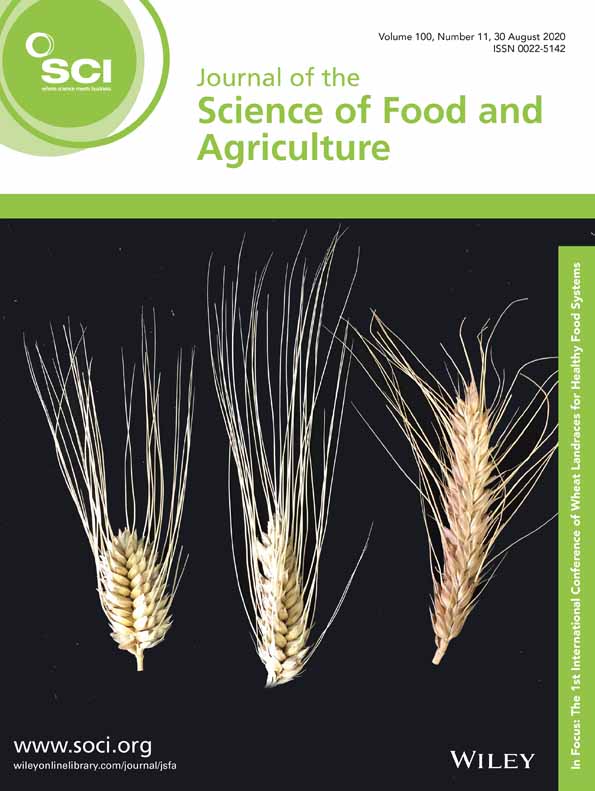Ver ítem
- xmlui.general.dspace_homeCentros Regionales y EEAsCentro Regional Mendoza - San JuanEEA JunínArtículos científicosxmlui.ArtifactBrowser.ItemViewer.trail
- Inicio
- Centros Regionales y EEAs
- Centro Regional Mendoza - San Juan
- EEA Junín
- Artículos científicos
- Ver ítem
Characterization of virgin olive oils from Spanish olive varieties introduced in Mendoza, Argentina and their comparison with the autochthonous variety
Resumen
BACKGROUND: The aim of this work was to evaluate and compare oil production and its quality in three Spanish olive varieties (Genovesa , Villalonga and Nevadillo blanco ) growing outside the Mediterranean basin with the Argentine autochthonous variety (Arauco ). Parameters on fruits and oil characteristics were evaluated on samples collected from Germplasm Collection of Mendoza province and elaborated in the same place.
RESULTS: The levels of phenolic
[ver mas...]
BACKGROUND: The aim of this work was to evaluate and compare oil production and its quality in three Spanish olive varieties (Genovesa , Villalonga and Nevadillo blanco ) growing outside the Mediterranean basin with the Argentine autochthonous variety (Arauco ). Parameters on fruits and oil characteristics were evaluated on samples collected from Germplasm Collection of Mendoza province and elaborated in the same place.
RESULTS: The levels of phenolic compounds and fatty acids composition of samples under study were comparable with those previously published for these Spanish varieties grown in the Mediterranean basin, showing the adaptability of olive trees. Specifically, observing the levels of phenolic compounds and oxidative stability, a strong correlation between oxidative stability and oleocanthal was observed.
CONCLUSION: Fruits and oil characteristics differed among varieties and seasons. The inter harvest stability was different according to the variety. Genovesa was observed as the most stable variety according to fruit and oil characteristics, even more stable than the autochthonous variety namely Arauco . However, according to the composition of phenolic compounds, Arauco was the most stable between harvests, being this characteristic more important for taste and uniformity of the product.
[Cerrar]

Autor
Banco, Adriana Pamela;
Trentacoste, Eduardo Rafael;
Monasterio, Romina Paula;
Fuente
Journal of the Science of Food and Agriculture (First published: 9 July 2020)
Fecha
2020-07
Editorial
Wiley
ISSN
0022-5142
1097-0010
1097-0010
Formato
pdf
Tipo de documento
artículo
Palabras Claves
Derechos de acceso
Embargado
 Excepto donde se diga explicitamente, este item se publica bajo la siguiente descripción: Creative Commons Attribution-NonCommercial-ShareAlike 2.5 Unported (CC BY-NC-SA 2.5)
Excepto donde se diga explicitamente, este item se publica bajo la siguiente descripción: Creative Commons Attribution-NonCommercial-ShareAlike 2.5 Unported (CC BY-NC-SA 2.5)
Metadatos
Mostrar el registro completo del ítemÍtems relacionados
Mostrando ítems relacionados por Título, autor o materia.
-
Evaluación de cultivares de trigo en la EEA Marcos Juárez. Actualización Campaña 2018.
Donaire, Guillermo Manuel; Gomez, Dionisio Tomas; Bainotti, Carlos Tomas; Fraschina, Jorge Alberto; Salines, Jose Hector; Alberione, Enrique Javier; Salines, Nicolas; Conde, María Belén; Mir, Leticia Raquel; Reartes, Fernando; Paolini, Haroldo Mario; Arce, Leonardo David (EEA Marcos Juárez, INTA, 2019-04-10)La Red Nacional de Evaluación de Cultivares de Trigo (RET) del INASE (SAI) con la participación de INTA y criaderos privados, realiza anualmente ensayos de evaluación de cultivares de trigo en diferentes localidades ... -
Evaluación de cultivares de trigo en Entre Ríos (Región I - Subregión Pampa mesopotámica). Ciclo agrícola 2021
Gieco, Lucrecia Cristina; Schutt, Lorena Silvana; Gallardo, Maricel Andrea; Ocampo, Oscar Alberto; Politi, Mariangeles (Estación Experimental Agropecuaria Paraná, INTA, 2022)La Estación Experimental Agropecuaria Paraná del INTA participa anualmente y desde 2005, de la Red de Ensayos Comparativos de Variedades de Trigo que coordina el Instituto Nacional de Semillas (INASE). En el presente informe ... -
Informe ensayo cebada cervecera Comarca Andina
Vago, Juan; Cardozo, Andrea; Sisón Cáceres, Leandro Axel; Reuque, Raul Esteban; Claps, Leonardo; Cobelo, Claudia Mónica (AER El Bolsón, INTA, 2018)La cebada cervecera o de 2 hileras (Hordeum vulgare L. convar. Distichon L.) es un cereal de invierno de gran similitud con el trigo. Se debe diferenciar de la cebada forrajera (Hordeum distichum L.), comúnmente llamada ...

